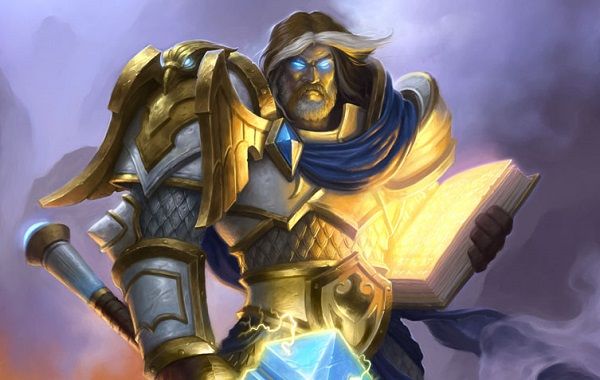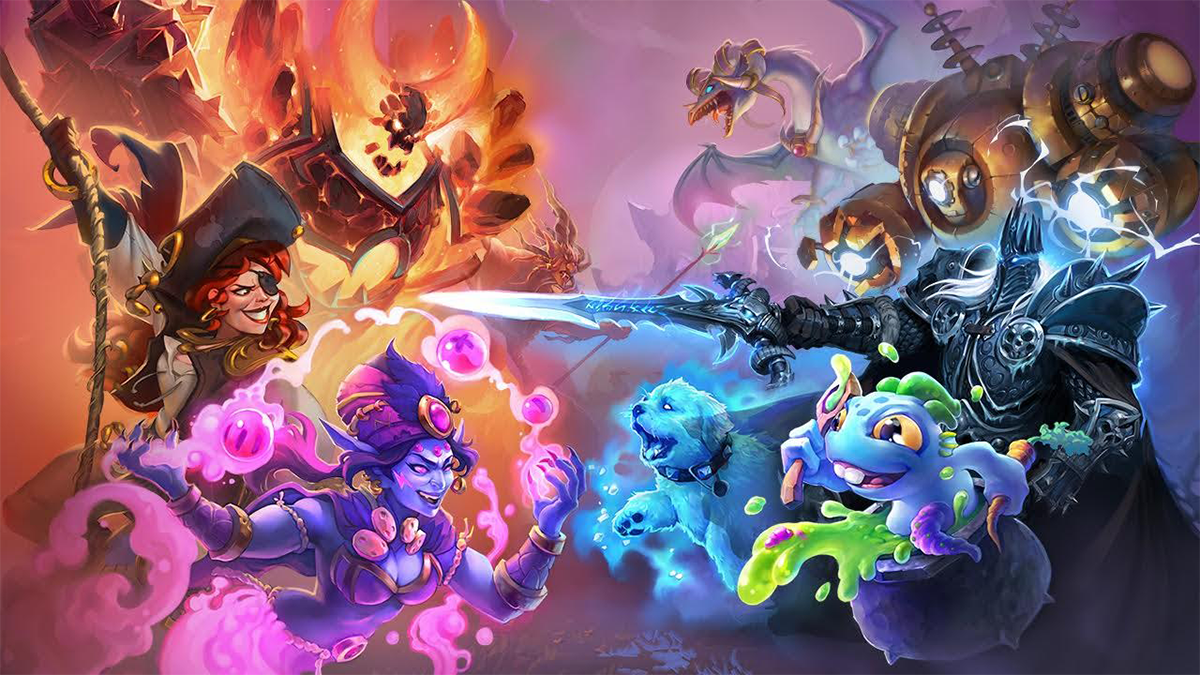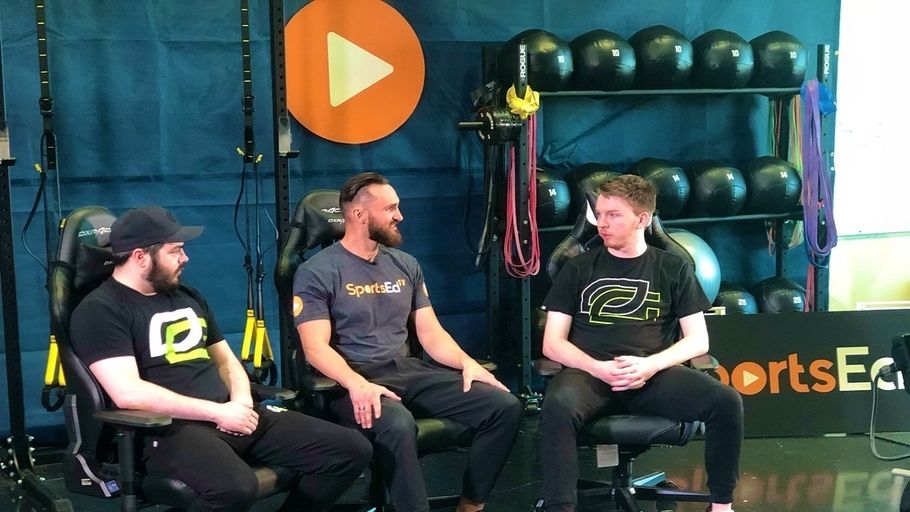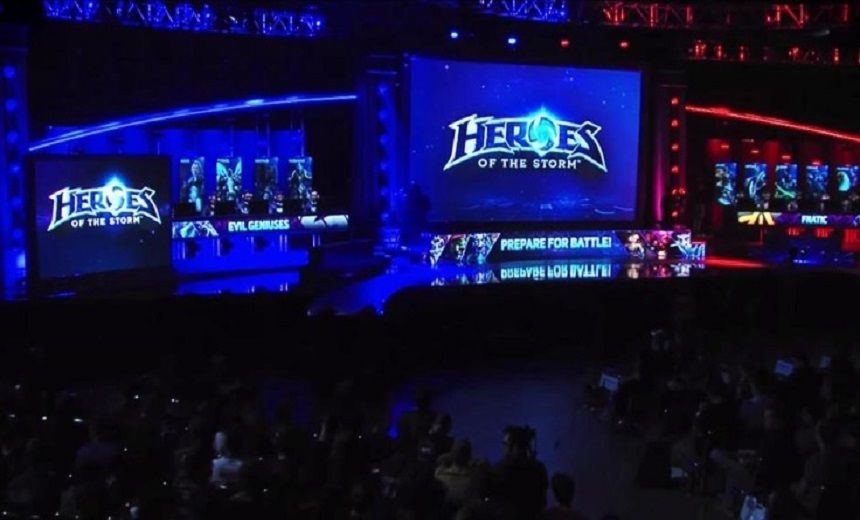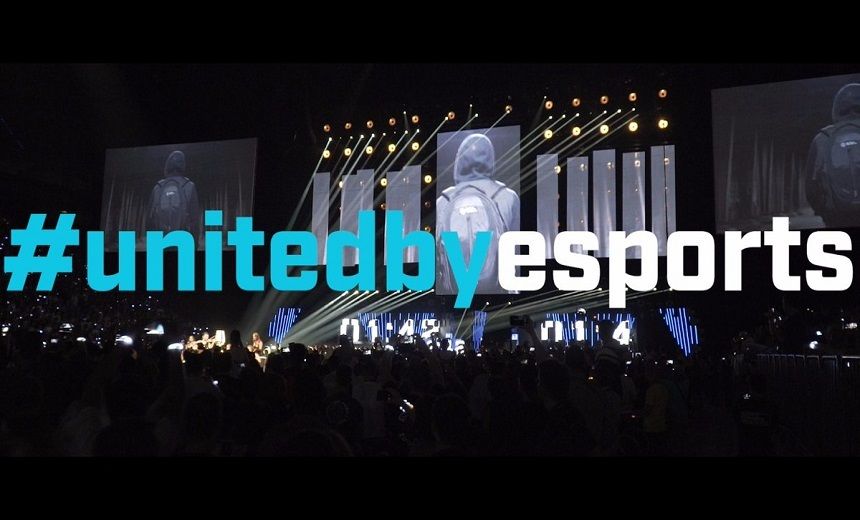Written by: Nydra Follow @GGNydrA
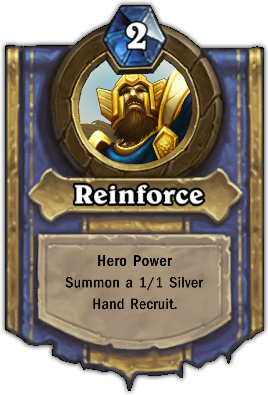
The Paladin is one the most diverse classes in Hearthstone. His cards allow the player to gain advantage through a variety of ways, be it through establishing board presence (hero power), reducing health or attack of opposing minions (Equality, Aldor Peacekeeper), sweeping the board (Consecration), healing himself or others (Lay on Hands), or using divine shield minions (Argent Protector) to trade in the most efficient way possible. He has card draw mechanics which, too, come in a variety of forms – creature buffs (Blessing of Wisdom), damage-dealing spells (Holy Wrath) or cards that let you catch-up to opponent’s hand size (Divine Favor).
Paladin’s hero power is Reinforce. Think of it as a version of the Mage or Druid spell powers in the sense that it deals 1 damage somewhere, but one that can benefit better from Paladin’s tools. Apart from establishing board presence, the 1/1 tokens can serve as targets for Blessing of Kings that turns them into 5/5 bodies or any other buffing spell, weapon or minion there is in Hearthstone. Like Mage’s Fireblast, they’re perfect for popping divine shields and dealing that last piece of damage that kills a minion. Reinforce has amazing synergy with Sword of Justice and also guarantees that you will never run out of minions to put on the field.
Playing and building a Paladin deck might be tricky unless you know the class well. Many of the cards work in synchrony and need to be played in the proper sequence. You’ll need to learn to survive as the first two turns will often be a problem for you: there aren’t any 1-drops in the Paladin collection and the neutral ones he uses are often played later to support minions already on the board.
Where the Paladin flourishes is in the mid and late stages of the game. There are some strong cards for 3 mana like Aldor Peacekeeper, Divine Favor and Sword of Justice but it is T4 that defines the Paladin. Truesilver Champion, Consecration, Blessing of Kings and Hammer of Wrath are real game turners and they’re what makes the Paladin incredible.
Playstyle-wise, there are two types of Paladins. The “miniatures” deck relies on small minions to flood the board, secrets that protect them and minions that buff them. The control, on the other hand, aims for the late game and hosts a number of healing spells and minions, potent board sweepers and end-of-the-curve legendaries to finish the game. The crafting section of this guide is segmented in such a way as to help you build the set-up of your preference.
As with every class, crafting the control version is expensive. You will need several epics and legendaries to make it work and that’s quite the investment.
Fortunately, whipping some budget miniatures is not that difficult. The deck on the right is entirely composed of free cards (and is what I used when I first started Hearthstone). The deck to the left only has two rares and twelve commons (total cost 680 dust) and is a poor man’s version of a full-bloodied miniatures deck.
The budget deck also features some of the mechanics that the ultimate aggro Paladin uses and will help you learn the class. You will get used to casting Noble Sacrifice in the correct moment, to protect Knife Juggler so you can extract value and to plan your drops leading into the mid-game turns.
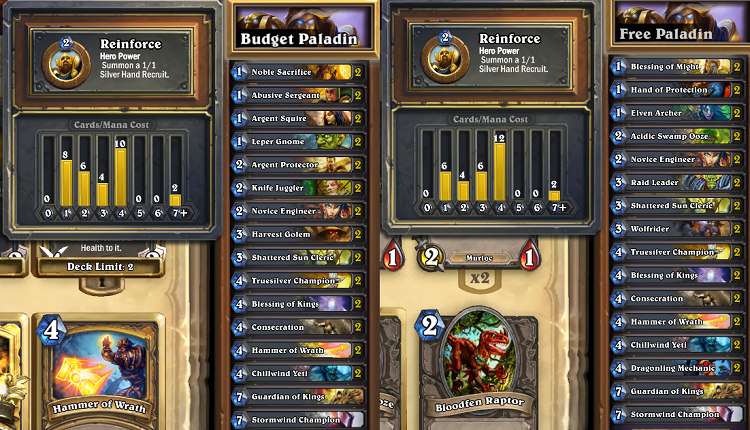
Did we mention crafting an ultimate Paladin deck is expensive? Well, it is. Get your dust ready – a lot of rares and epics will be needed.
I. The essentials
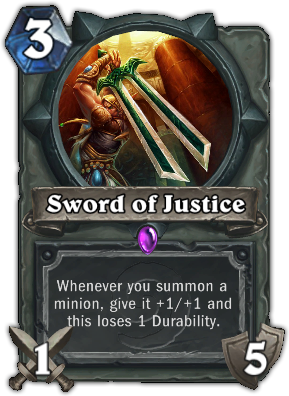 Sword of Justice is among the best weapons in the game and is a must in both aggro and control Paladins. It turns your recruits into 2/2s. It keeps your 2-health minions out of Demonfire/Holy Nova/Blizzard/Starfall/etc. range. It kills 1-health minions and is great for popping divine shields. No matter how you spin it, this will likely be your first epic craft as a Paladin. Its only drawback is that it needs some time before it really kicks off. It’s a dead card for the first four turns and you don’t want to draw it too early.
Sword of Justice is among the best weapons in the game and is a must in both aggro and control Paladins. It turns your recruits into 2/2s. It keeps your 2-health minions out of Demonfire/Holy Nova/Blizzard/Starfall/etc. range. It kills 1-health minions and is great for popping divine shields. No matter how you spin it, this will likely be your first epic craft as a Paladin. Its only drawback is that it needs some time before it really kicks off. It’s a dead card for the first four turns and you don’t want to draw it too early.
Another must-have epic is Avenging Wrath which pings eight times for 6 mana. Although the damage is allocated randomly, Avenging Wrath will more often than not yield the preferred outcome especially if you have established board control before that. The utility of this card is amazing and it can work as a toughness-softener, finisher or board sweeper when paired with Equality. It especially shines against control Mages who don’t have board presence and will take direct 8 damage on T6 but it will also deal with the popular aggro decks who often run low-toughness minions.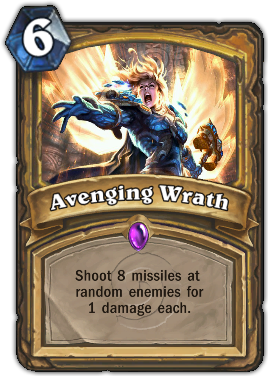
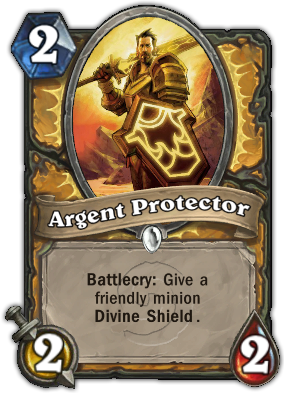 There’s a common card for a change but one that you’ll want to craft as soon as possible. Argent Protector’s battlecry will divine shield a minion of your choice which will often generate a 2-for-1 trade. He’s the idea way of protecting Knife Juggler, re-shielding your Argent Commander or, worst case scenario, turn your recruits into Argent Squires. He can’t shield himself, though, so you’ll want to wait for another minion first.
There’s a common card for a change but one that you’ll want to craft as soon as possible. Argent Protector’s battlecry will divine shield a minion of your choice which will often generate a 2-for-1 trade. He’s the idea way of protecting Knife Juggler, re-shielding your Argent Commander or, worst case scenario, turn your recruits into Argent Squires. He can’t shield himself, though, so you’ll want to wait for another minion first.
II. Crafting for aggro
With the aggro Paladin you will run a myriad of small creatures and you’ll want to protect them through every way possible. Sword of Justice will help to some extent but it’s slow and sometimes you’ll need to pull a trick out of your sleeve immediately. This is where Noble Sacrifice and Redemption come in.
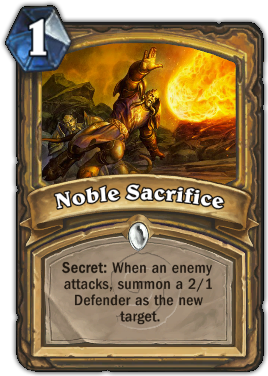 Aggro players will grow to love Noble Sacrifice immensely. When triggered, the secret spawns a 2/1 defender to block an attacking enemy minion, thus protecting said minion’s original target.
Aggro players will grow to love Noble Sacrifice immensely. When triggered, the secret spawns a 2/1 defender to block an attacking enemy minion, thus protecting said minion’s original target.
Noble Sacrifice retains its value all throughout the game. In the early turns, it serves as a protection for your Knife Juggler and will trade 1-for-1 with most minions or at least soften them enough so that they can be finished by a recruit. It will soak up the heavy swings from Warrior’s axes or Paladin’s Truesilver Champions and deal 2 damage to the hero as a bonus. In the later stages, it will protect high-value targets (like the Argent Commanders) or soak up some damage, potentially preventing a lethal blow.
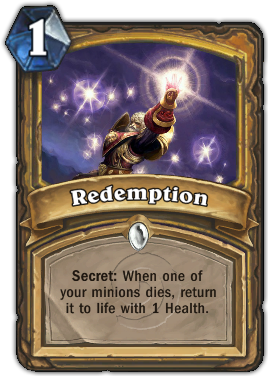 Redemption is just as fun to use and, too, has several uses. The most obvious one is playing it preemptively when you expect that a valuable minion will be killed. Option two is to play it, make a one-for-one trade minion-wise and get your stuff back. Option three, though, is where Redemption truly excels. As the card revives the minion with all its abilities, it synergizes perfectly with Argent Squire and Argent Commander. The shieldless Commander/Redemption combo is especially powerful as you can kill a minion by sacrificing the Commander, get it back with divine shield and charge on via Redemption and attack again for another 4 damage somewhere. Be smart and careful when you use this secret, though – you’ll often run one-of in your aggro and you wouldn’t want to waste its potential.
Redemption is just as fun to use and, too, has several uses. The most obvious one is playing it preemptively when you expect that a valuable minion will be killed. Option two is to play it, make a one-for-one trade minion-wise and get your stuff back. Option three, though, is where Redemption truly excels. As the card revives the minion with all its abilities, it synergizes perfectly with Argent Squire and Argent Commander. The shieldless Commander/Redemption combo is especially powerful as you can kill a minion by sacrificing the Commander, get it back with divine shield and charge on via Redemption and attack again for another 4 damage somewhere. Be smart and careful when you use this secret, though – you’ll often run one-of in your aggro and you wouldn’t want to waste its potential.
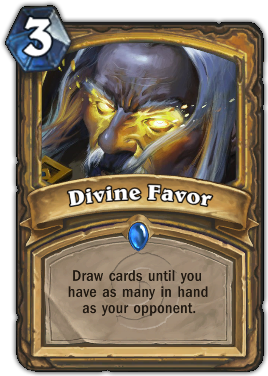 Divine Favor is a powerful way to catch up with the hand size of your opponent. Aggro Paladins tend to empty their hands fast and/or run out of steam past the mid-turns and Divine Favor gets them back in the game. This is a card especially useful against control decks that run a lot of draw techniques (Mages, Priests) but even against aggros you’ll often draw 2 for 3 mana, essentially casting Arcane Intellect.
Divine Favor is a powerful way to catch up with the hand size of your opponent. Aggro Paladins tend to empty their hands fast and/or run out of steam past the mid-turns and Divine Favor gets them back in the game. This is a card especially useful against control decks that run a lot of draw techniques (Mages, Priests) but even against aggros you’ll often draw 2 for 3 mana, essentially casting Arcane Intellect.
III. Crafting for mid-range control
Lay on Hands is Paladin’s most powerful healing spell. At 8 mana, it’s a strictly late-game card which returns a quarter of hero’s health back and refills the hand by drawing three cards. This makes LoH especially powerful against late-game oriented decks such as the popular Mage controls, the Priest controls that can be seen in the higher layers of ranked mode and, of course, in Paladin control mirrors.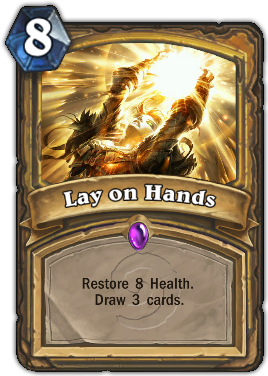
Magic: The Gathering players will see resemblance between Lay on Hands and Sphinx’s Revelation and will immediately recognize the power of the card. The fact that it draws three cards alongside the healing (usually, cards that just return health are not that highly valued in TCGs and are often disregarded or ran in small quantities as counters to certain meta) makes it a 2-in-1 deal that completely justifies the high mana cost. It’ll often be the saving grace that heals you up just before Pyroblast hits or what delivers you the missing piece in your late-game puzzle (i.e. Tirion/Ragnaros, more heal, board control mechanics, etc.).
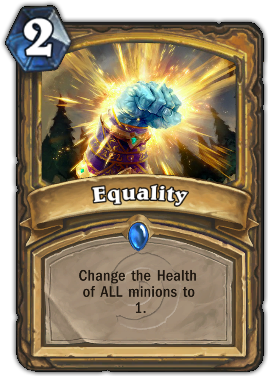 Equality is another card you’ll always run in mid/late-game oriented Paladins. It’s an essential piece in powerful board sweepers when paired with Consecration, Avenging Wrath or Wild Pyromancer and is what helps the slower Paladins stay alive till late game. It’s also an effectual way to deal with Druid decks’ high-toughness minions (Ancient of War, Druid of the Claw, Ysera, Ragnaros) or definitively clear a highly populated board with buffed-up minions.
Equality is another card you’ll always run in mid/late-game oriented Paladins. It’s an essential piece in powerful board sweepers when paired with Consecration, Avenging Wrath or Wild Pyromancer and is what helps the slower Paladins stay alive till late game. It’s also an effectual way to deal with Druid decks’ high-toughness minions (Ancient of War, Druid of the Claw, Ysera, Ragnaros) or definitively clear a highly populated board with buffed-up minions.
Another thing that makes Equality great is the place of the combos that use it in the mana curve. Coin excluded, Pyromancer/Equality comes on T4, Equality/Consecration can be cast on T6 and Equality/Avenging Wrath on T8. It’s a sequence similar to Mage’s 3-5-7 (CoC, Blizzard, Flamestrike) and will make opponents play with caution as populating the board in one turn will be punished on the next.
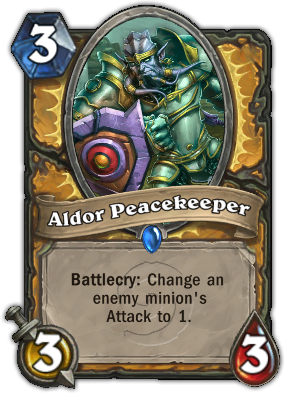 Aldor Peacekeeper is another card that retains its value all throughout the game. Reducing an enemy minion to 1 attack will help establish better trades, butcher late-game finishers (1/8 Giants are not as scary as 8/8 giants) and will protect your late-game minions from dying to a heavy swing. In addition, the Peacekeeper is a 3/3 body for 3 that’ll deal with most of the mid-game threats, thus helping the Paladin to stay alive longer and more easily maintain board control.
Aldor Peacekeeper is another card that retains its value all throughout the game. Reducing an enemy minion to 1 attack will help establish better trades, butcher late-game finishers (1/8 Giants are not as scary as 8/8 giants) and will protect your late-game minions from dying to a heavy swing. In addition, the Peacekeeper is a 3/3 body for 3 that’ll deal with most of the mid-game threats, thus helping the Paladin to stay alive longer and more easily maintain board control.
Tirion Fordring is a card that returned to the meta now with the decline of Priest decks and when players stopped running silence galore. Surviving till 8 mana is very doable with a control Paladin and dropping Tirion on T8 is among the best things you can do. Unless there’s a hard removal or silence waiting, Tirion will protect the legendaries you’ll play next (most often Ragnaros) and upon dying will equip a 5/3 weapon, thus donating a 15 damage over 3 turns. The card is a powerful defender, heavy hitter and finisher in one package so running it should be a no-brainer, unless you fear it'll be silenced. 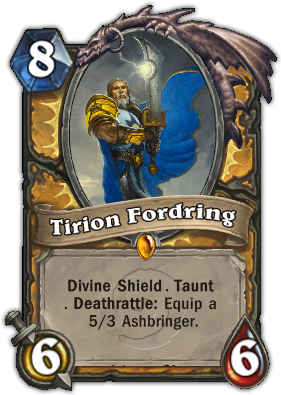
III. To the neutral pool!
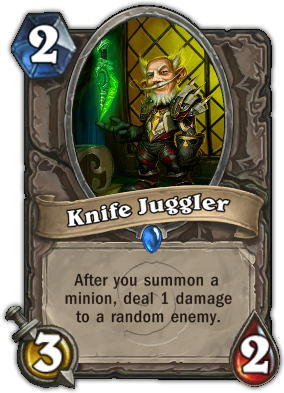 Knife Juggler is a great card overall and one that works wonders in Paladin decks. The class has a lot of ways to keep it alive (Argent Protector, Noble Sacrifice, Redemption, Sword of Justice) as well as an easy way to trigger it constantly through Reinforce. It’s mostly a core for aggro Paladins but some control versions run it too for mid-game pressure.
Knife Juggler is a great card overall and one that works wonders in Paladin decks. The class has a lot of ways to keep it alive (Argent Protector, Noble Sacrifice, Redemption, Sword of Justice) as well as an easy way to trigger it constantly through Reinforce. It’s mostly a core for aggro Paladins but some control versions run it too for mid-game pressure.
Leper Gnome, Argent Squire, Abusive Sergeant and Southsea Deckhand are another four good crafts if you want to go full agro. The first two are a pain to deal with and are easy value while the Deckhand and the Sergeant are a charging 2 damage that catches opponents by surprise. You’ll, of course, want a pair of Harvest Golems, Defenders of Argus and Argent Commanders just like every aggro deck out there. Some aggro builds also consider Bloodsail Raiders but I’ve personally found them ineffectual. Granted, they become a 4/4 or 6/3 for 2 but they need a weapon and when there isn’t one in play they’re kind of a dead card (they can still be dropped as a 2/3 for 2 but there are better 2-mana plays that should take priority).
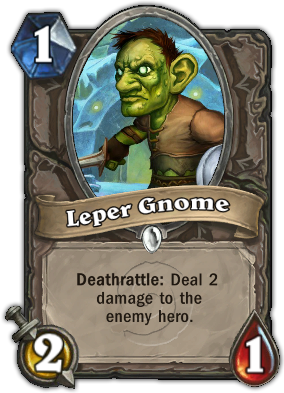
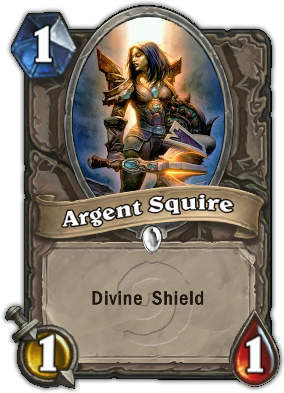
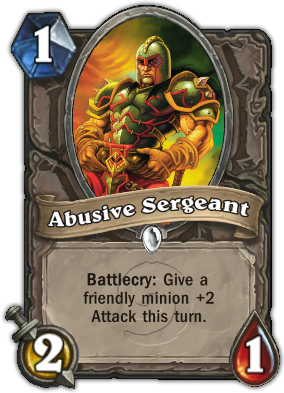
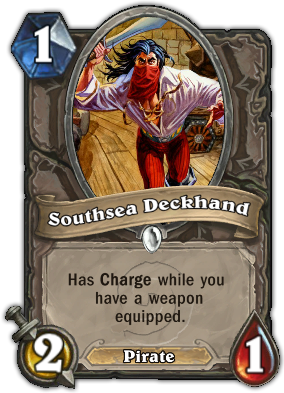
Wild Pyromancer and Ragnaros should be considered for the mid-range control builds. The Pyromancer works well with Equality as we mentioned and Ragnaros is a natural choice for end-of-curve finishers, especially if you’ve already established board control (an easy task with the aforementioned Equality).
Finally, you’ll want Sylvanas because she’s great. It fits every deck currently in fashion and until the meta shifts towards silence-heavy decks you’ll want her in your collection.
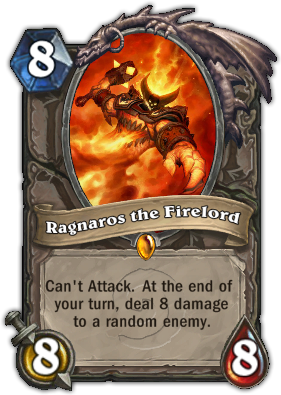
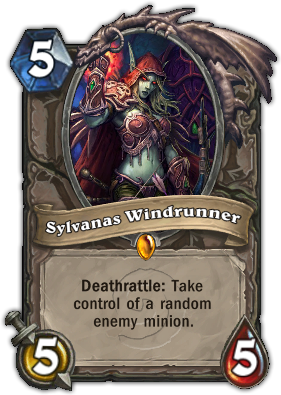
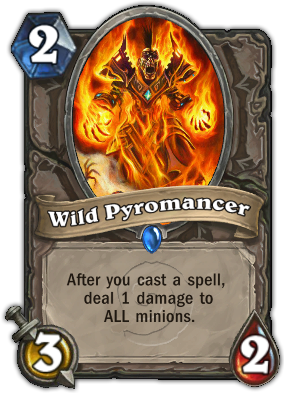
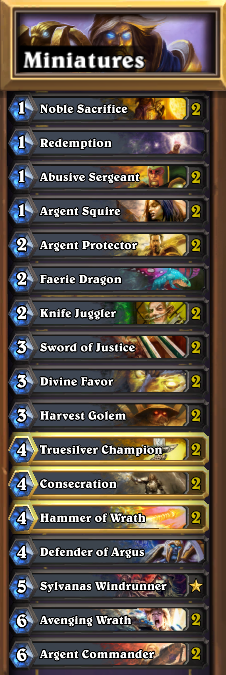 I. Miniatures
I. Miniatures
Popularized by Cixah, the miniatures are a standard aggro deck that plays a lot of small, cheap minions in attempt to rush down the opponent before the late game. It makes use of Paladin’s hero ability to maintain board presence and pressure and implements class-specific techniques like Argent Protector, Noble Sacrifice and Redemption to protect high-value drops.
The Sword of Justice and the Knife Juggler are the MVPs of the miniatures aggro (alongside the ubiquitous Truesilver Champion). SoJ will add +1/+1 to every minion that you play, making it a harder to kill or big enough to trade efficiently with opponent’s minions. It works especially well with Noble Sacrifice (the Defender grows to 3/2 and can survive Druid’s and Rogue’s hero powers) and Harvest Golem (giving you a 3/4 that spawns a 3/2). It will also keep the Jugglers out of Holy Nova/Blizzard/Starfall range and will turn the Southsea Deckhand (if you decide to play one) into a charging 3/2 for 1.
The Knife Juggler, on the other hand, often pays off easily in Paladin decks. It can be triggered every turn by Reinforce while hiding behind class-specific defensive mechanisms.
Unlike other aggro classes like Warlocks or Rogues, the miniatures don’t have a strict decklist that everyone should follow. Some versions run the Pirate duos of Southsea Deckhand and Bloodsail Raider to extract even more value out of their weapons. Other add additional 1-drops like Leper Gnome for extra early damage, use Leeroy for finishing 6 damage and even play Ragnaros to end the curve and provide some late-game presence. Hammer of Wrath and Blessing of Kings are interchangeable depending on player preferences, too. The deck on the right is what I currently run on Rank 6.
The miniatures’ big problem is their bad T1 and T2. Unless an Argent Squire is drawn in the opening hand, the deck takes off slowly. Even though a handful of 1-drops are run, they’re dependent on having something on the field already (Abusive

Sergeant needs another minion, Southsea Deckhand needs a weapon). As a result, the miniatures will often have problems against decks that rarely get a bad early start (e.g. Warlocks or aggro Mages) and must rely on a strong mid-game to gain advantages.
II. Control
The Paladin control forgoes aggression to incorporate mass removals, healing and end-game legendaries and/or heavy bodies. Even though it has existed for a long time, the deck gained a lot of popularity only recently as a counter to Mages’ control dominance as many of its cards soak up the Mage burn. It’s also a sort of coming to terms with Paladin’s weak first two turns and taking advantage of the strong mid-game cards the class has.
The diversity of the Paladin class shows even more when building a control deck and it can be designed to suit almost every playstyle. The deck on the right, for example, is a mix between pressure and late-game stability. Elements of the miniatures like Faerie Dragon and Knife Juggler are used to deal some early damage while Argent Commander is used for charging 4 damage and a way to clear the board from unwanted threats. It runs 2x Consecration for board sweep on T4 and 2x Equality/Consecration combos to erase the opponent’s board on T6. Once board control is established, Ragnaros comes in to finish the job. Single copies of Lay on Hands and Guardian of Kings keep the hero alive while providing card draw/board presence at the same time.
Other versions of the Paladin control go into more defensive set-ups. They abandon aggression and run dual Wild Pyromancer for extra board control. They also implement Holy Light and an extra copy of Guardian of Kings to more effectively counter Mages, include Tirion as an additional 8-drop or even run Twilight Drakes to take advantage of their big hand sizes. Sub-versions replace the Argent Commanders with Sunwalkers or even add Ysera (although the latter is somewhat uncommon). Check this build to get the general idea of how an extra-defensive Paladin looks like.
Druid -
Hunter - Crafting + Unleash the Hounds combo + Beast beat-down
Mage - Crafting + Aggro Mage + Ice Block control
Paladin - Crafting + Miniatures + Mid-range/Control
Priest -
Rogue -
Shaman - Crafting and building the mid-range control
Warlock - Crafting + Aggro Warlock + Murlocs + Board control Warlock
Warrior -

